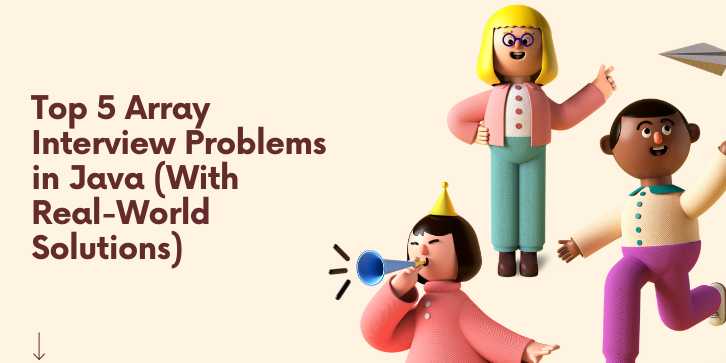Chapters
Top 5 Array Interview Problems in Java (With Real-World Solutions)

Problem #1: Find the First Repeating Element in an Array
🧠 Problem Statement
Given:
An array of integers.
Task:
Find the first element that repeats. The second occurrence should be the
earliest among all repeating elements.
Return:
The repeating element. If none exists, return -1.
🧾 Sample Input/Output
Input:
int[] arr = {10, 5, 3, 4, 3, 5, 6};
Output:
5
Explanation:
Both 5 and 3 repeat, but 5 repeats first in the array.
🔍 Naive Brute-Force
Approach
Compare every element with every other element that comes
after it.
public
static int firstRepeatingNaive(int[] arr) {
for (int i = 0; i < arr.length; i++) {
for (int j = i + 1; j < arr.length;
j++) {
if (arr[i] == arr[j]) {
return arr[i];
}
}
}
return -1;
}
⛔ Time Complexity: O(n²)
⛔
Space Complexity: O(1)
✅ Works, but too slow for large
arrays.
⚡ Optimized Approach Using
HashSet
Track seen elements using a Set while traversing the array in
reverse.
import
java.util.*;
public
class RepeatingElement {
public static int
firstRepeatingElement(int[] arr) {
Set<Integer> seen = new
HashSet<>();
int result = -1;
for (int i = arr.length - 1; i >= 0;
i--) {
if (seen.contains(arr[i])) {
result = arr[i]; // This is the
earliest repeated from right
} else {
seen.add(arr[i]);
}
}
return result;
}
public static void main(String[] args) {
int[] arr = {10, 5, 3, 4, 3, 5, 6};
System.out.println(firstRepeatingElement(arr)); // Output: 5
}
}
✅ Why Reverse Loop?
Because it ensures we find the first repeating element
(in original order) — the earliest second occurrence.
🧠 Edge Cases
|
Input |
Output |
Explanation |
|
{1, 2, 3, 4, 5} |
-1 |
No repeats |
|
{2, 2, 3, 4, 5} |
2 |
Immediate repeat at the start |
|
{5, 1, 2, 3, 1, 2} |
1 |
1 repeats before 2 again |
|
{} |
-1 |
Empty array |
📈 Time & Space
Complexity
|
Complexity |
Value |
|
Time |
O(n) |
|
Space |
O(n) (for HashSet) |
🧨 Interview Variants
- "Return
the index of first repeating element"
👉 Track both value and index using Map<Integer, Integer> - "Return
all repeating elements"
👉 Use Map<Integer, Integer> to count frequency - "In-place
solution?"
👉 Only if values are in known limited range (e.g. 1 ≤ arr[i] ≤ n)
✅ Recap: Key Takeaways
- Use
Set to detect duplicates efficiently
- Reverse
traversal gives correct repeat order
- Watch
out for multiple correct-looking repeats
- O(n²)
brute-force may pass small test cases — not optimal for large data
FAQs
1. Why are array problems so common in Java interviews?
Because
they test core programming logic, data handling, loops, and algorithm
efficiency.
2. What’s the difference between int[] and Integer[] in Java?
int[] is a primitive array; Integer[] is an array of objects (wrappers). The latter allows null values and works with collections.
3. Is it better to use Arrays or ArrayLists in interviews?
For fixed-size problems, use arrays. For dynamic data, ArrayList is better — but stick to arrays unless otherwise asked
4. What are common pitfalls in Java array questions?
Index out of bounds, mutating arrays while iterating, and forgetting that Java arrays have fixed size.
5. How do I remove duplicates from a Java array?
Use a Set for uniqueness or sort the array first and remove duplicates in-place using two pointers.
6. When should I use the two-pointer technique?
It’s great for sorted arrays, especially for problems involving pair sums, removing duplicates, and reversing data in-place.
7. How can I rotate an array in Java?
Use reversal techniques or cyclic replacements to do it in O(1) space.
8. What’s the time complexity of array search vs binary search?
Linear search = O(n); binary search = O(log n), but only on sorted arrays.
9. How do I handle negative numbers or large input arrays?
Always consider edge cases: empty arrays, one element, all duplicates, etc. Optimize with hashmaps or prefix sums where needed.
10. What libraries or classes help with arrays in Java?
Use Arrays.sort(), System.arraycopy(), Arrays.toString(), and Collections when applicable — but show the manual solution first in interviews.
Tutorials are for educational purposes only, with no guarantees of comprehensiveness or error-free content; TuteeHUB disclaims liability for outcomes from reliance on the materials, recommending verification with official sources for critical applications.
Explore Other Libraries
Please allow ads on our site
Kindly log in to use this feature. We’ll take you to the login page automatically.
Login
Join Our Community Today
Ready to take your education and career to the next level? Register today and join our growing community of learners and professionals.

Your experience on this site will be improved by allowing cookies. Read Cookie Policy
Your experience on this site will be improved by allowing cookies. Read Cookie Policy

Comments(0)